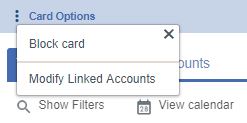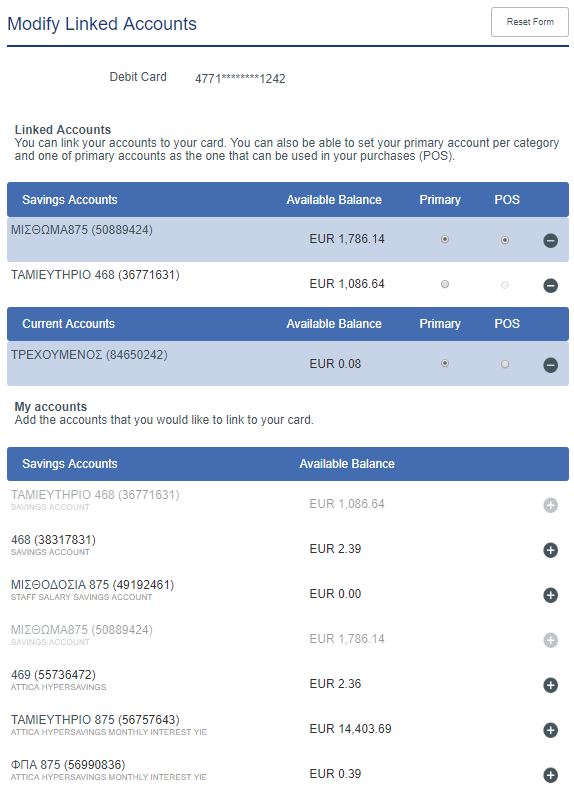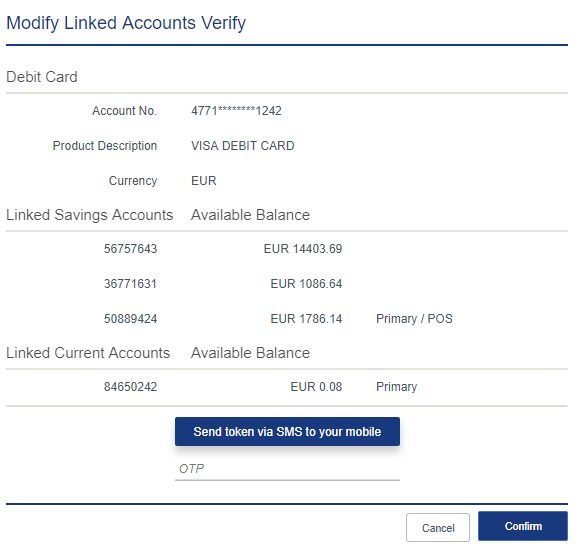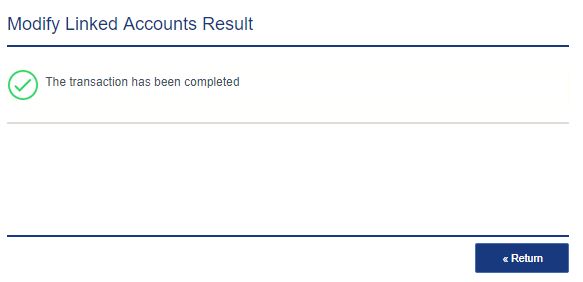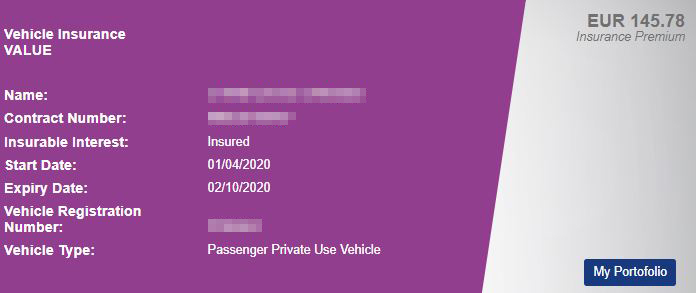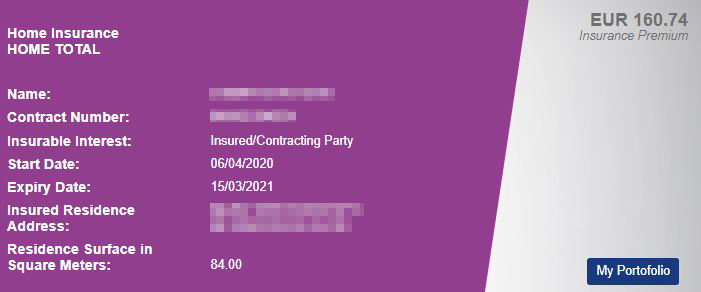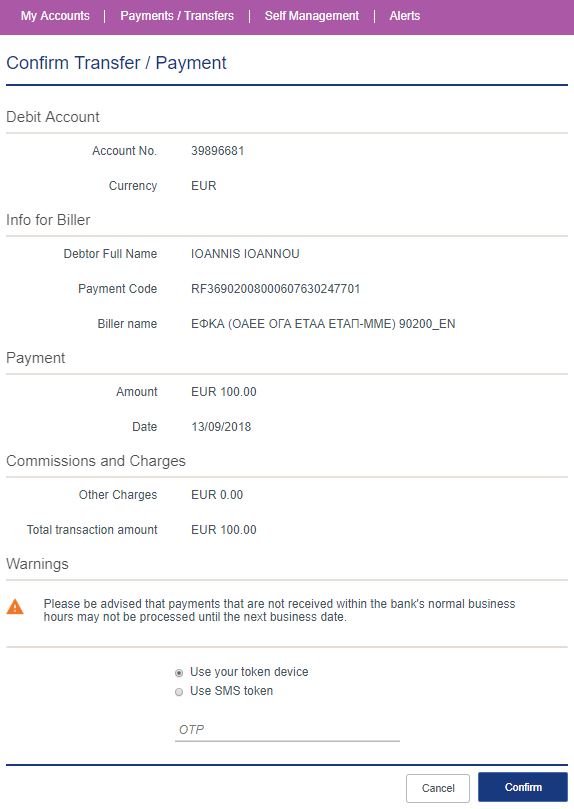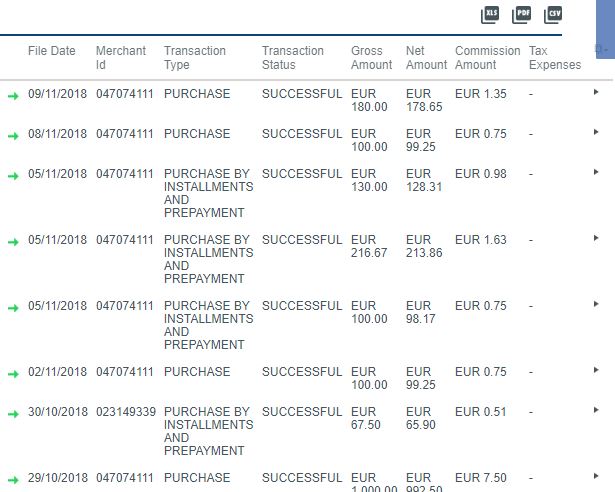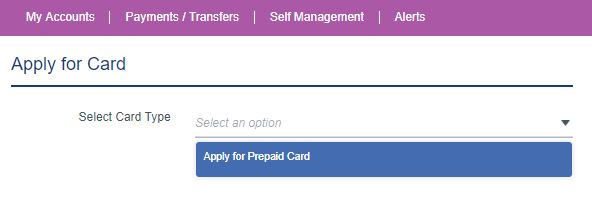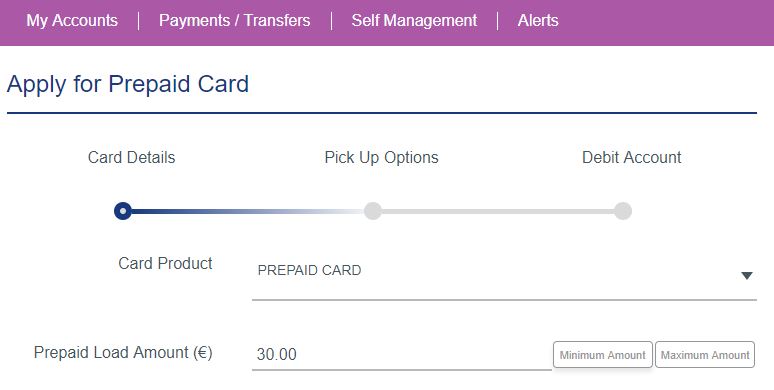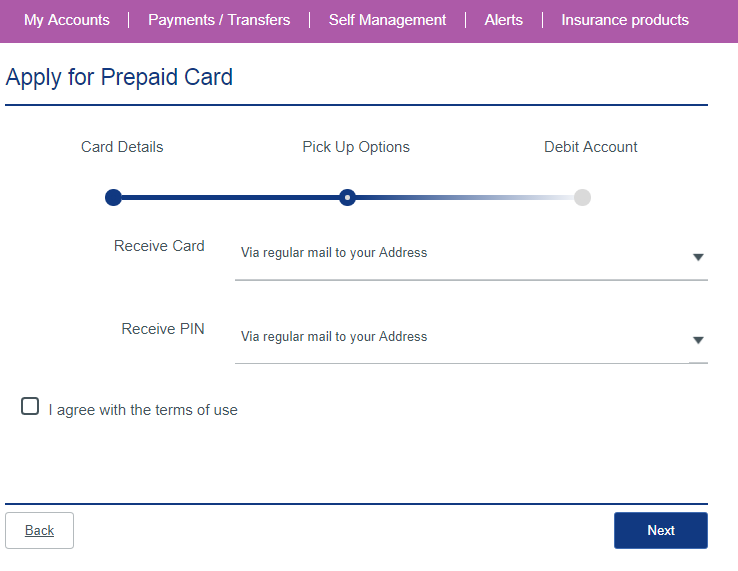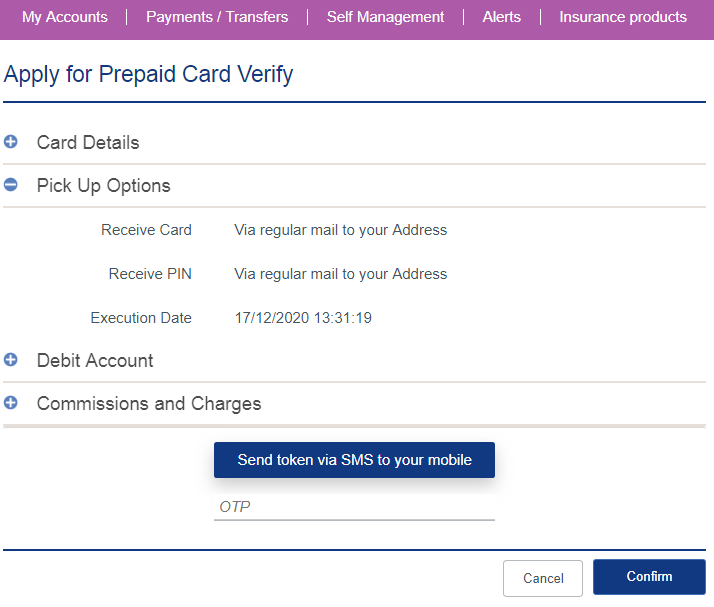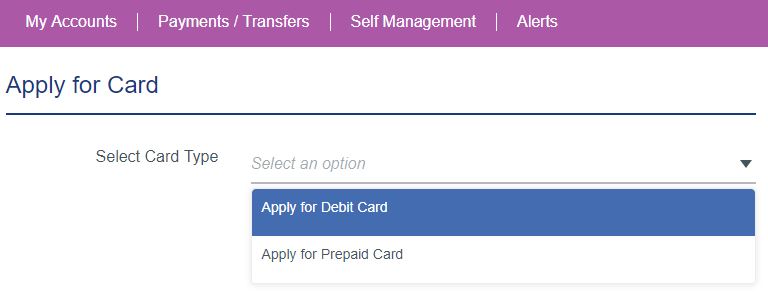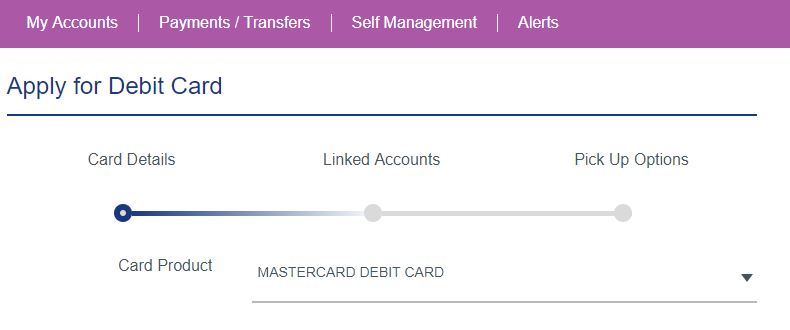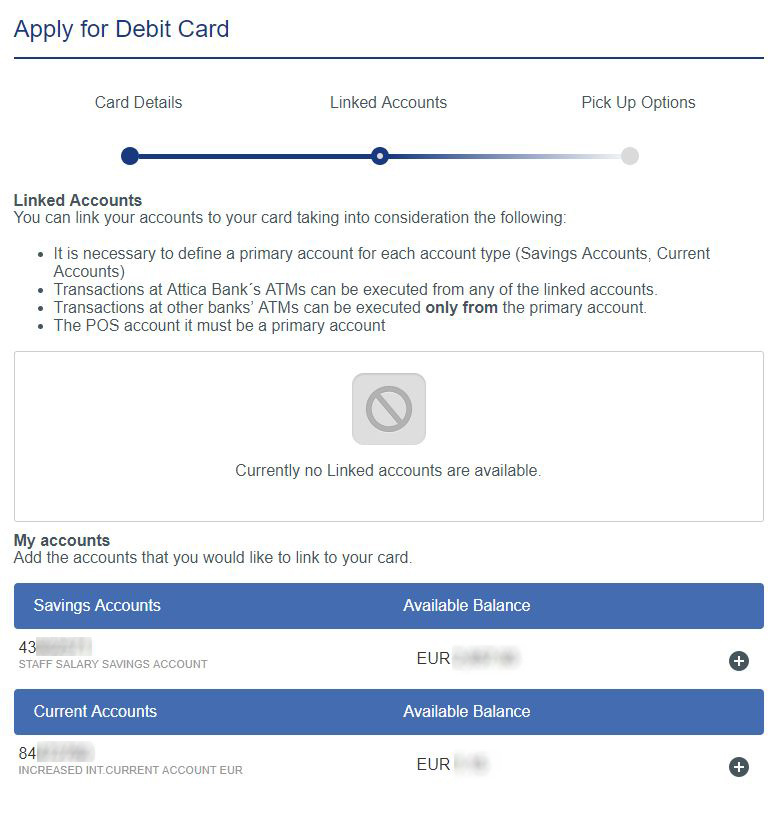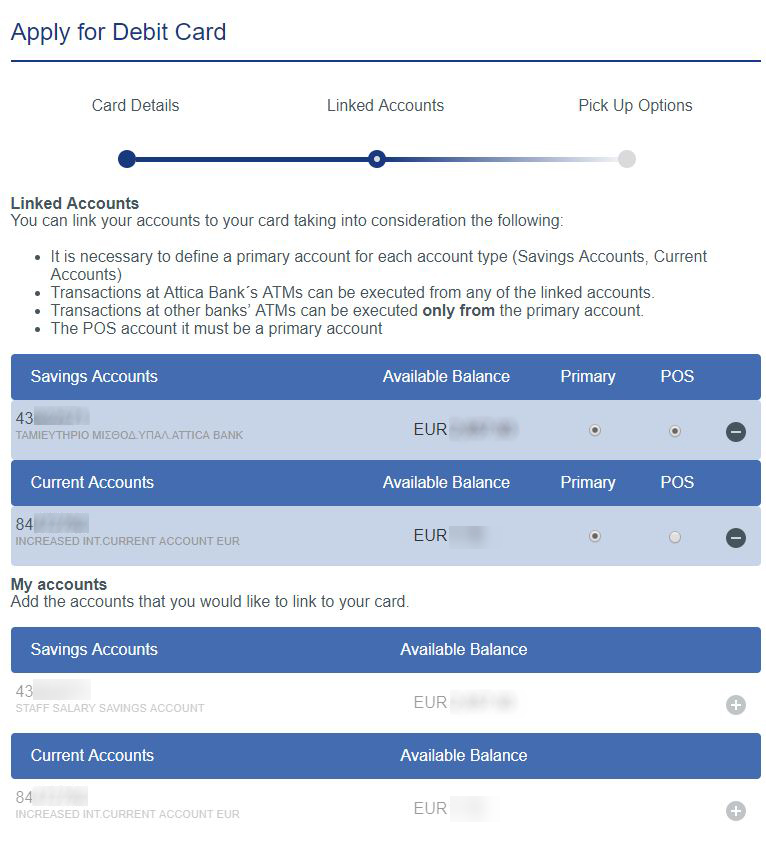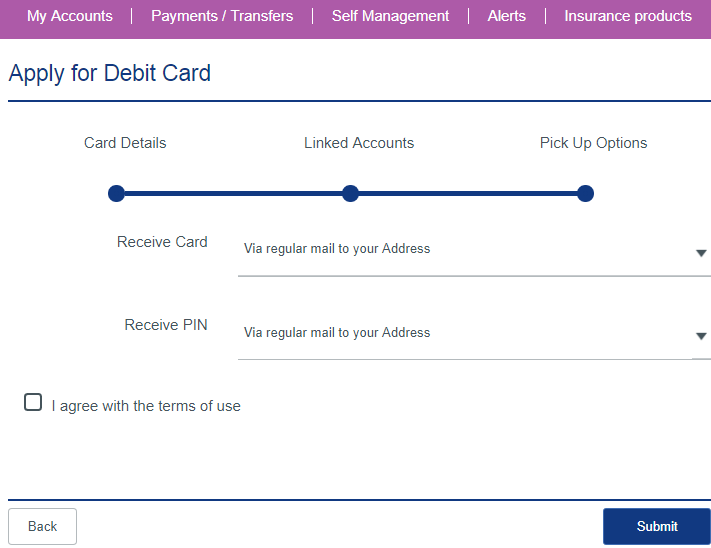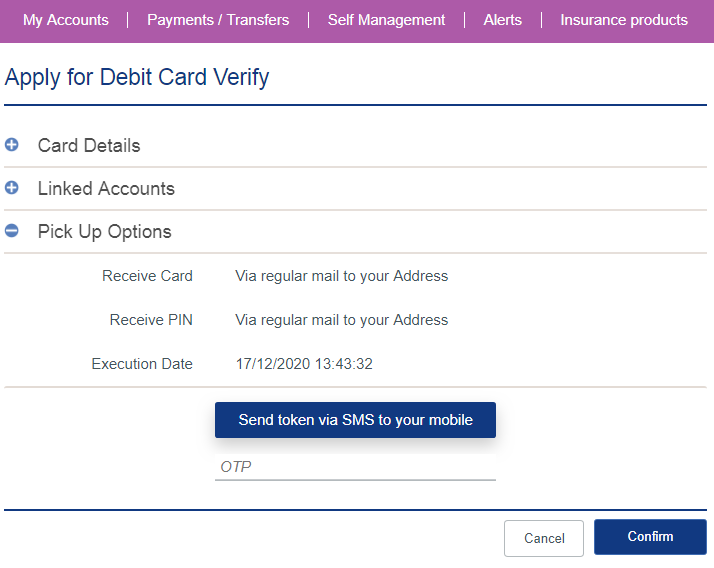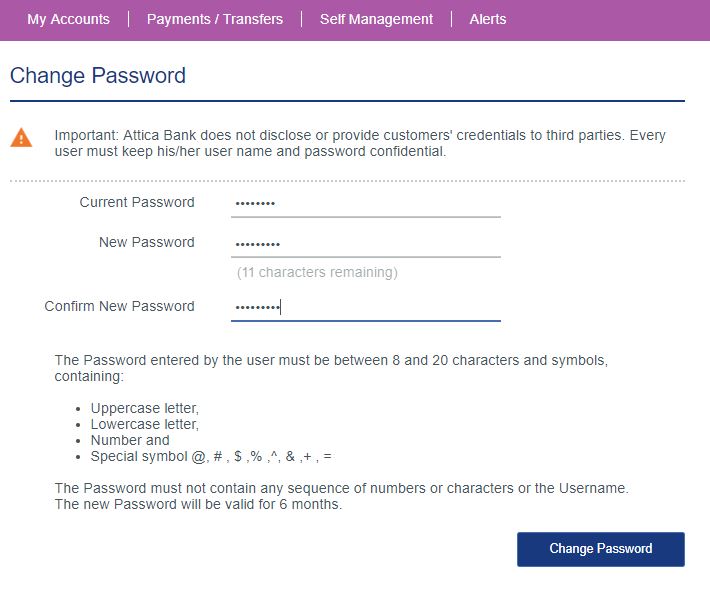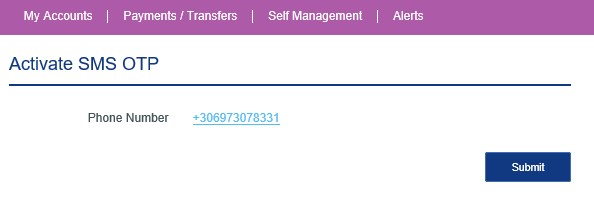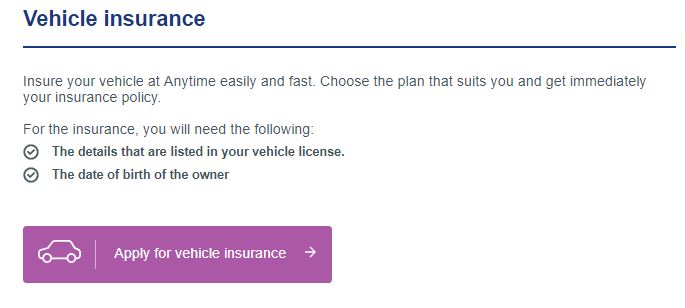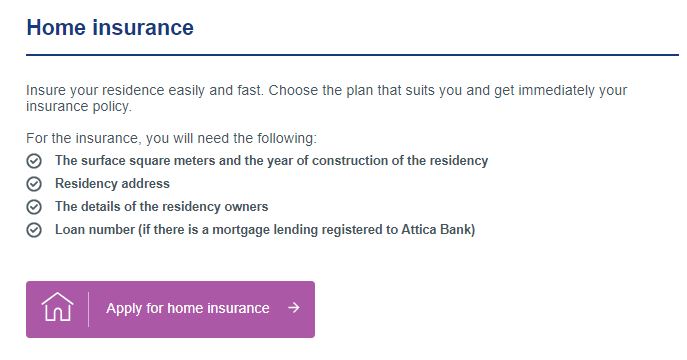Read the detailed instructions on how to use Attica e-banking.The instructions are broken down per transaction. Click on the title to open the enriched article that describes each transaction in detail.
Dashboard
Welcome to the new Attica e-banking! From now on, you can manage your accounts safely and independently and make your transactions quick and easy with a range of options at your disposal.
E-banking homepage menu is splitted into 4 categories:
- “My Accounts”, where you can view your portfolio, containing a full list of your bank accounts and cards.
- “Payments/Transfers”, where you can pay your bills to Organizations or Utility Companies, transfer funds to your accounts, to another Attica bank account or other domestic or overseas accounts (transfers via DIAS). You can also pay your credit cards, create and delete direct debits and standing orders, order checkbooks and more.
- “Self Management”, where you can manage your personal credentials and your bank accounts. In more detail, you can change your username/password, manage your accounts/beneficiaries/templates and register your devices to Attica Mobile. Finally, you can also activate the Hardware Token and SMS OTP generation services.
At the top of the homepage, as of every other page throughout your e-banking navigation, you can view a toolbar containing the following icons:
- Attica bank’s logo. By clicking on it, you are transferred to Attica bank’s homepage.
- “Branches”. By clicking on it, you are redirected to the corresponding page of the Attica bank’s site where all Branches & ATMs are listed.
- Attica bank’s Contact number.
- “Language” selection option (Greek/ English).
Attica e-banking logo is also visible at the top left corner of the homepage, as in any other navigation page through the application, where it gives you the option, by clicking on it, to redirect to the e-banking’s dashboard (homepage). The same redirection can also be achieved by clicking on the icon  , at the top of the right corner of any navigation page.
, at the top of the right corner of any navigation page.
- Clicking the messages icon
 , you can view the secure messages sent by Attica Bank to you, through the Attica e-banking application. You can reply to these secure messages or create a new message.
, you can view the secure messages sent by Attica Bank to you, through the Attica e-banking application. You can reply to these secure messages or create a new message.
When you click on “New Message”, the following page will pop-up, where you will be requested to select a specific Topic from a pre-selected list of options and define the Subject of your message. There is also a text field where you can write the content of your inquiry. At the bottom of this framework, you have the choice to “Add an Attachment”, by clicking on the “Browse” button. When you complete your message, click on “Send” and then “Confirm” on the “Confirmation of sending the message” pop-up window that will be displayed on your screen.
- If you need any assistance, at any point throughout your navigation, you can click on the help icon
 , which is located at the top right corner’s toolbar of any navigation page, and you will be redirected to a menu which contains the User Manuals of Attica e-banking.
, which is located at the top right corner’s toolbar of any navigation page, and you will be redirected to a menu which contains the User Manuals of Attica e-banking. - In order to log out from Attica e-banking, you can click the ON/OFF icon
 , located at the top right corner toolbar.
, located at the top right corner toolbar.
The application provides information regarding your last login to the Attica e-banking or Attica Mobile and gives you an update concerning the total Available Funds and total Ledger Funds of your accounts (Current & Savings).
At the right column of the homepage, the following information is shown:
- The Upcoming Transactions, if any, where you can see your standing orders (recurring) or future transactions that are expected to be completed in the upcoming future (This information corresponds to the list of Active transfers that can be found on the Payments/Transfers menu). In case you have more than 5 upcoming transactions, you can click on “More Transactions”, where you will view a pop-up window which contains all of your upcoming transactions. To any of these transactions, by selecting the corresponding option, you can view more information, delete it, or view the details of any transaction which has already incurred. For more related information, see paragraph “List of Active Transfers”.
- The Tax Free Expenses for the latest 2 fiscal years are shown. By clicking on the dropdown list for a particular year and selecting a specific entry you can view a more detailed description regarding your expenses per category.
My Accounts
Please select the type of the account you are interested in.
My portfolio
Selecting “My Portfolio” from “My Accounts” menu, you can view analytically and broken down by category your Deposit accounts, Loans, Time Deposit accounts, Mutual funds or your Debit, Credit and Prepaid Cards. In the heading of each category there is a symbol (+/-). Clicking on it, you can view the details of each category or minimize it as shown below: 
Furthermore, there is the option to move the categories as well as the individual accounts of each category according to the display order of your preference. Select the icon  to the right of each category and then, by drag and drop you can reorder the way the particular categories will be displayed. In the same way, in order to move any particular account within its category, again by drag and drop, you can select the order of preference as shown below:
to the right of each category and then, by drag and drop you can reorder the way the particular categories will be displayed. In the same way, in order to move any particular account within its category, again by drag and drop, you can select the order of preference as shown below:
Finally, by doubleclicking on any account, you are re-directed to a page containing detailed information about the account you are interested in.
Savings Accounts/Current Accounts
The following information appears on the screen:
- the nickname, the number and the product type of the account (there is a dropdown list where you can view these details of any other account of interest)
- the IBAN of the account
- the type of the account
- the date and the branch where the account was opened
- the beneficiaries
- the special terms (if any)
- the inactive account flag
- the available balance
- the ledger balance
- the overdraft approved (for current accounts)
- the total holds (if any)
Except for the aforementioned basic details of the account, the following information is also provided at the bottom of the page:
- Transaction History
In this Tab, you can see all the transactions that were realized with that account through any channel (e.g. e-banking, mobile, ATMs, Branches) during the last month. For each transaction, except for the transaction date and its reference number, the description and the amount that was debited or credited and the updated ledger balance are also shown. For each transaction, you can select the icon to the right ![]() and see additional information about it.
and see additional information about it.
If you wish to view transactions for a smaller or a larger period of an account, you can do it by changing the default date settings from the filters.
Furthermore, by clicking on “View calendar”, you can see in which days of the month you carried out the transactions, in order to facilitate your search to a particular transaction.
Finally, the transaction history can be downloaded to a csv, pdf or xls file respectively.
- Active Transactions
In this Tab, you are able to view your upcoming future or recurring (standing orders) transactions.
- Holds
In this Tab, you can view details referencing to any holding amount for the account of your interest.
Loans
In Loans, except for the nickname, the reference number and the product type, the following information appears on the screen:
- the disbursement amount
- the loan expiry date
- the branch
- the loan service account
- the contract date
- the contract number
- the beneficiaries
- the outstanding balance
- the current interest rate
- the next payment amount
- the overdue amount
On the second half of the page, the account Transaction History is also available.
In this Tab, you can see all the transactions that were carried out during the last month. If you wish to view a smaller or a larger sample of the transactions, you can do it by changing the default date settings from the filters.
Furthermore, by clicking on “View calendar”, you can see in which days of the month you carried out the transactions, in order to limit your search to a particular transaction. For each transaction, except for the transaction date and its reference number, the description and the amount that was debited or credited are also shown.
For each transaction, you can select the icon to the right  and hence see any additional information relating to it. Finally, the transaction history can be downloaded as a csv, pdf or xls file.
and hence see any additional information relating to it. Finally, the transaction history can be downloaded as a csv, pdf or xls file.
Debit Cards
In the details of Debit Cards, the following information is available to the user:
- the nickname, the card number (masked) and the type of the debit card (there is a dropdown list where you can view the same details of any other account of interest)
- the expiry date
- the branch
- the linked accounts
- the cardholder name
- the card status
- the daily limit for purchases
- today purchases
- the daily limit for withdrawals
- today withdrawals
At the bottom of the debit card’s detail screen, by selecting “Card Options” you can block your card, if there is an appropriate reason to do so (card was stolen, lost etc.)
When you select to block your card, in the following screen you will have to select the card select the reason and click on “Submit”.
After you click on “Submit”, you will be requested to enter an One-Time-Password (OTP) via a Hardware Token or SMS Token. Then, after reviewing the details, click on “Confirm” on the pop-up window that follows.
As in the case of savings accounts and loans, the Transaction History is also availableon the second half of the page.
In this Tab, you can see all the transactions that were carried out during the last month. If you wish to view a smaller or a larger sample of the transactions, you can do it by changing the default date settings from the filters.
Furthermore, by clicking on “View calendar”, you can see in which days of the month you carried out the transactions, in order to limit your search to a particular transaction. For each transaction you can see the transaction date, the reference number, the description and the amount that was debited or credited.
For each transaction, you can select the icon to the right ![]() and hence see any additional information about the transaction. Finally, the transaction history (based on the filters you have selected) can be downloaded to a csv, pdf or xls file.
and hence see any additional information about the transaction. Finally, the transaction history (based on the filters you have selected) can be downloaded to a csv, pdf or xls file.
Modify Linked Accounts
Linked accounts menu is located next to Transactions history tab and refer to those accounts which are linked to your debit card as shown below:
Linked accounts are displayed in two categories: Savings Accounts and Current Accounts. In each of these categories, it is obligatory for one PRIMARY account to be linked to and also for one of these PRIMARY accounts to be POS Account at the same time.
PRIMARY account is the account from which you can authorize cash withdrawals via ATM while on the other hand, POS is the account which is used for your purchases via POS terminals.
Every debit card is linked with at least one account which is characterized as Primary and POS. There could be linked, though, more than one accounts in each category. The limit is 12 per category. The accounts are categorized as following:
- One primary per category (Savings or Current)
- Rest secondary per category and
- One unique POS account which will act as PRIMARY at the same time.
Attica e-banking and Attica Mobile offers you the potential to modify, each time you wish, the accounts which are linked to your debit card. By choosing Modify Linked Accounts, as shown above, or via Card Options and Modify Linked Accounts option, as shown below, you are directed to Modify Linked Accounts page.
Up to this screen, you can view which accounts are linked to your debit card, which of those are PRIMARY in each category and which is the account linked to purchases via POS, as well as which other accounts are available to be linked to your card. These accounts are displayed as well divided in two categories: Savings and Current Accounts.
In order to link one of your accounts to your debit card, you should choose the account you wish from my Accounts and move it to your Linked Accounts by choosing the (+) symbol which is located in its right part. Automatically, this specific account is being moved to Linked Accounts and next to it (in its right part) the symbol (-) is displayed. And vice versa, by selecting the (-) symbol, you can revoke the connection of an account with your debit card.
In order to select PRIMARY accounts as well as POS, you should select one radio button from each category (Current, Savings) and then one POS from the primary ones using again radio buttons.
To save changes, you should select Submit. Following, you will be directed to the next page, Modify Linked Accounts Verification.
At this point of the process, you should insert a one-time password via SMS or Hardware Token and confirm the transaction. You will be directed to the relevant screen where you are informed that the transaction has been completed.
Credit Cards
In the details of Credit Cards, the following information is available to the user:
- the nickname, the card number (masked) and the type of card (there is a dropdown list where you can view the same details of any other account of interest)
- the expiry date
- the card status
- the cardholder name
- the add-on card number (if any)
- the add-on cardholder name
- the available balance
- the ledger balance
- the card purchase limit
- the latest statement balance
- the last payment amount
- the minimum payment until the relevant date
- the latest statement’s issue date
- the total amount of installments (if any)
On the second half of the page, you can, the user can find the following information:
- Transaction History
In this Tab, all the transactions that were carried out after the last credit card statement issue are shown. For each transaction, you can select the icon to the right  and hence see additional information. Finally, the transaction history can be downloaded to a csv, pdf or xls file.
and hence see additional information. Finally, the transaction history can be downloaded to a csv, pdf or xls file.
- Pre – Authorizations
In the Pre-Authorizations Tab, credit card charges that have not yet been cleared are shown. The amount is hold until the transaction is cleared. 
- Previous Statement
You can view your last issued statement, in an electronic form.
Prepaid Cards
In the details of Prepaid Cards, the following information is shown:
- the nickname, the card number and the type of card (there is a dropdown list where you can view these specific details of any other account of interest)
- the expiry date
- the card status
- the cardholders name
- the limit
- the used amount
- the current balance
On the second half of the page, you can find the following information:
- Transaction History
In this Tab, you can see all the transactions that were carried out during the last month. For each transaction, you can select the icon to the right ![]() and hence see any additional information. Finally, the transaction history can be downloaded to a csv, pdf or xls file.
and hence see any additional information. Finally, the transaction history can be downloaded to a csv, pdf or xls file.
- Pre- Authorizations
In this Tab, prepaid card charges that have not yet been cleared are shown. The amount is hold until the transaction is cleared.
Time Deposits
In the Time Deposits Tab, the following information is available:
- the nickname and the account product type of the time deposit
- the branch and the date that the account was opened
- the maturity date
- the interest disposition account
- the beneficiaries
- the ledger balance
- the current interest rate
- the next interest payment
Please note that you cannot transfer funds from and to your Time Deposits through Attica e-banking.
Insurance Products
Vehicle Insurance
The information that is shown for Vehicle Insurance is written below:
- The Name and Surname of the contract owner
- The Contract Number
- The Insurable Interest which describes the relationship between the Customer and the contract and can get the following values: Contracting party, Insured or Insured / Contracting party.
- The Start Date of the Contract
- The Expiry Date of the Contract
- The Vehicle Registration Number
- The Vehicle Type
- The Insurance Premium
Home Insurance
The information that is shown for Home Insurance is written below:
- The Name and Surname of the contract owner
- The Contract Number
- The Insurable Interest which describes the relationship between the Customer and the contract and can get the following values: Contracting party, Insured or Insured / Contracting party.
- The Start Date of the Contract
- The Expiry Date of the Contract
- The Insured Residence Address
- The Residence Surface in Square Meters
- The Insurance Premium
Transactions
Please select the section you are interested in
Transfers
Own Account Transfers
With this transaction, you can transfer funds between your own accounts.
Select the “From Account” and the “To Account” and enter the “Amount”. Select whether this transfer will be a “Single Transaction” or a “Standing Order” (recurring transfer) and determine the “Transaction Date”. Furthermore, you are given the option to include any “Comments”. Click on “Submit” and then “Confirm” on the confirmation pop-up window that will follow in order for the transaction to be fulfilled.
If you click on “Cancel”, the transaction will be cancelled and you will be redirected to the transaction homepage.
This transaction is set, by Attica bank, not to need any further Authentication (OTP). You can also save this transaction as a template.
Intrabank Transfers
With this transaction, you can transfer funds to third party’s Attica Bank account. As it is shown below, you have to enter the “From Account”, the 8-digit “Beneficiary Account No” (as soon as you enter the account number, Attica bank will check the details provided, and if true, the beneficiary’s details will automatically be shown) and the “Amount”. Alternatively, you can select an already saved beneficiary. In addition, you may add any “Comments”.
Select if this is going to be a “Single Transaction” or a “Standing Order” (recurring transfer) and determine the “Transaction Date”.
Click on “Submit”. You will be requested to enter a One-Time-Password (OTP) either via a Hardware Token or SMS. After reviewing your transaction details, click on “Confirm”.
After you confirm the transaction, and it is successfully completed, a “Cyber Receipt” will be displayed on the result page. By clicking on it, you have the following 2 options: you can either download the transaction receipt or send it via email. In case the transaction fails to be completed, an error message appears on the screen, containing the reasons for this failure.
In addition, you can save this transaction as a template by selecting the “Save this transaction as template”.
While creating a template for this transfer the application gives you the option to adjust the preauthorized amount. In more detail, you are able to make transfers up to the amount that you have set without having to enter a One-Time-Password (OTP). The maximum preauthorized amount limit that can be adjusted for a template for payments/transfers is set by Attica bank.
Wire Transfers - Transfer funds within SEPA Region (DIAS)
With this transaction, you can transfer funds to a beneficiary’s account of another domestic or foreign bank (via DIAS). As it is shown in the form, you have to enter the “From Account”, the “Beneficiary Account No (IBAN)”, the “Beneficiary’s Name” and the “Amount”. Alternatively, you can select an already saved Beneficiary. Also, without being mandatory, you can enter the ”Beneficiary’s Address” and add any “Comments”.
In addition, you can select if this transaction is going to be a “Single Transaction” or a “Standing Order” (recurring transfer) and determine the “Transaction Date”. Click on “Submit”. You will be redirected to the confirmation page where you will be requested to enter a One-Time-Password (OTP) via Hardware Token or SMS. In order to proceed, click on “Confirm”.
After you confirm the transaction, and it is successfully completed, a “Cyber Receipt” will be displayed on the result page. By clicking on it, you have the following 2 options: you can download the transaction receipt or send it via email. In addition, you can save this transaction as a template by selecting the “Save this transaction as template”.
While creating a template for this transfer the application gives you the option to adjust the preauthorized amount. In more detail, you are able to make transfers up to the amount that you have set without having to enter a One-Time-Password (OTP). The maximum preauthorized amount limit that can be adjusted for a template for payments/transfers is set by Attica Bank.
In case the transaction fails to be completed, an error message appears on the screen, containing the reasons for this failure.
Payments
Payments- Pay your Bill to a Utility Company
With this transaction, you can make bill payments to an Organizaton or a Utility company. Select the “From Account”and the “Biller”. On the Biller dropdown list, there is a text frame, where if you type part of the biller’s name or part of the biller’s reference number, the dropdown list is narrowed down so that you can more easily and quickly select the biller of interest. After you make your biller selection, the corresponding frames will open in order to be filled in.
By selecting the “Help” link, you can find further information for the Organization or Utility Company.
In the section that follows, you can find instructions relating to bill payments as well as some special billers:
- Billers with one Payment Code
- e-Paravolo Payment
- Ergosimo - Labour Ticket Payment
- TSMEDE Semester Proceeds
- TSMEDE Settlement Installment Payments with Notice
- EYDAP- Payments to EYDAP
- Teli Kykloforias
- Certified Debts- Payments to Tax Office
Billers with one payment code
Select a ”From Account” and a “Biller”. On the Biller dropdown list, there is a text frame, where if you type part of the biller’s name or part of the biller’s reference number, the dropdown list is narrowed down so that you can more easily and quickly select the biller of interest. Enter the “Amount”, select if this payment is going to be a “Single Transaction” or a “Standing Order” (recurring payment), determine the “Transaction Date” (same date or future date), enter the person’s liable for payment “Name” and the “Payment Code «of the bill.
If you need further information regarding the organization/utility company you are about to make a payment to, you can select the “Help” link. A new window will open containg information and pictures related to the organization/utility company of interest.
 Click on “Submit”. A One-Time-Password (OTP) will be requested via either a Hardware Token or SMS. Enter the OTP and click on ”Confirm”. After you confirm the transaction, and successfully completed, a “Cyber Receipt” will be displayed on the result page. By clicking on it, you have the following 2 options: you can either download the transaction receipt or send it via email. In addition, you can choose this bill payment to be saved as a template by selecting the “Save this transaction as template”.
Click on “Submit”. A One-Time-Password (OTP) will be requested via either a Hardware Token or SMS. Enter the OTP and click on ”Confirm”. After you confirm the transaction, and successfully completed, a “Cyber Receipt” will be displayed on the result page. By clicking on it, you have the following 2 options: you can either download the transaction receipt or send it via email. In addition, you can choose this bill payment to be saved as a template by selecting the “Save this transaction as template”.
In case the transaction fails to be completed, an error message appears on the screen, containing the reasons for this failure.
While creating a template for this payment the application gives you the option to adjust the preauthorized amount. In more detail, you are able to make payment up to the amount that you have set without having to enter a One-Time-Password (OTP). The maximum preauthorized amount limit that can be adjusted for a template for payments/transfers is set by Attica Bank.
E-paravolo
E-Paravolo is a functionality for the payment of an e-paravolo through the application. Select the “From Account” and type on the “Biller” some of the letters of the “e-paravolo” e.g. type e-p. The biller dropdown list will be narrowed accordingly so that you can select in a more easy way “e-paravolo”. After you select the biller, the corresponding frames will open in order to be filled in. Enter the “Amount”, the person’s liable for payment “Name”, the “Payment Code (Part 1)” and the “Payment Code (Part 2)”.
If you need further information regarding e-paravolo payment, you can select the “Help” link. A new window will open containg information and pictures related to it.
Then, click on “Submit”.
A One-Time-Password (OTP) will be requested via either Hardware Token or SMS. Enter the OTP and click on ”Confirm”. After you confirm the transaction, and it is successfully completed, a “Cyber Receipt” will be displayed on the result page. By clicking on it, you have the following 2 options: you can either download the transaction receipt or send it via email.
In case the transaction fails to be completed, an error message appears on the screen, containing the reasons for this failure.
Ergosimo - Labour Ticket Payment
Ergosimo - Labour Ticket Payment is used for a labour’s payment in some specific cases of the private sector.
Ergosimo - Labour Ticket Payment is used for a labour’s payment in some specific cases of the private sector.
In case you wish as an employer to pay the Ergosimo-Labour Ticket Payment for one of your employees, select the “From Account” and type on the “Biller” some of the first letters e.g. type erg. The biller dropdown list will be narrowed accordingly so that you can select in a more easy way “Ergosimo”. After you make your biller selection, the corresponding frames will open in order to be filled in. (Be careful: these are the official details which have been referenced to HDIKA).
If you need further information regarding Ergosimo payment, you can select the “Help” link. A new window will open containg information and pictures related to it.
Click on “Submit”. A One-Time-Password (OTP) will be requested via either Hardware Token or SMS. Enter the OTP and click on ”Confirm”. After you confirm the transaction, and it is successfully completed, three “Cyber Receipts” will be displayed on the result page: Transaction receipt, Employer’s receipt and Employee’s receipt. By clicking on it, you have the following 2 options: you can either download the receipt(s) or send it (them) via email.

In case the transaction fails to be completed, an error message appears on the screen, containing the reasons for this failure.
In addition, you can choose this bill payment to be saved as a template by selecting the “Save this transaction as template”. While creating a template for this payment the application gives you the option to adjust the preauthorized amount. In more detail, you are able to make payment up to the amount that you have set without having to enter a One-Time-Password (OTP). The maximum preauthorized amount limit that can be adjusted for a template for payments/transfers is set by Attica bank.
TSMEDE Semester Proceeds
To pay the TSMEDE Semester Proceeds, select the “From Account” and type on the “Biller” some of the letters of the “TSMEDE Semester proceeds” e.g. TSM. The biller dropdown list will be narrowed accordingly so that you can select in a more easy way “TSMEDE Semester proceeds”. After you make your biller selection, the corresponding frames will open in order to be filled in. Enter the “Notice Number”.
If you need further information regarding TSMEDE Semester Proceeds payment, you can select the “Help” link. A new window will open containg information and pictures related to it.
Click on “Submit”. A One-Time-Password (OTP) will be requested via either Hardware Token or SMS. Enter the OTP and click on ”Confirm”.
After you confirm the transaction, and it is successfully completed, a “Cyber Receipt” will be displayed on the result page. By clicking on it, you have the following 2 options: you can either download the transaction receipt or send it via email.
In case the transaction fails to be completed, an error message appears on the screen, containing the reasons for this failure.
TSMEDE Settlement Installment Payments with Notice
To pay the TSMEDE Settlement Installment Payments with Notice, select the “From Account” and type on the “Biller” some of the letters of the “TSMEDE Settlement Payments” e.g. TSM. The biller dropdown list will be narrowed accordingly so that you can select in a more easy way “TSMEDE Settlement Installemets Payments with Notice”. After you make your biller selection, the corresponding frames will open in order to be filled in. Then, enter the “Notice Number”
If you need further information regarding TSMEDE Settlement Installemets Payments with Notice payment, you can select the “Help” link. A new window will open containg information and pictures related to it.
Click on “Submit”. A One-Time-Password (OTP)will be requested via either Hardware Token or SMS. Enter the OTP and click on ”Confirm”.
After you confirm the transaction, and it is successfully completed, a “Cyber Receipt” will be displayed on the result page. By clicking on it, you have the following 2 options: you can either download the transaction receipt or send it via email.
In case the transaction fails to be completed, an error message appears on the screen, containing the reasons for this failure.
Payments to EYDAP
In order to make a bill payment to EYDAP, select the “From Account” and type on the “Biller” some of the letters of “EYDAP” e.g. EYD. The biller dropdown list will be narrowed accordingly so that you can select in a more easy way “EYDAP – Payments to EYDAP”. After you make your biller selection, the corresponding frames will open in order to be filled in. Then enter the “Amount”, the “Name”, the “Voucher Number «and the “Expiration Date” as referenced on the EYDAP bill.
If you need further information regarding EYDAP payment, you can select the “Help” link. A new window will open with detailed information and pictures.
Click on “Submit”. A One-Time-Password (OTP) will be requested via either Hardware Token or SMS. Enter the OTP and click on ”Confirm”. After you confirm the transaction, and it is successfully completed, a “Cyber Receipt” will be displayed on the result page. By clicking on it, you have the following 2 options: you can either download the transaction receipt or send it via email.
In case the transaction fails to be completed, an error message appears on the screen, containing the reasons for this failure.
Teli Kykloforias
In order to pay Teli Kykloforias enter the “From Account” and type on the “Biller” some of the letters of the “TELI KYKLOFORIAS” e.g. Teli. The biller dropdown list will be narrowed accordingly so that you can select in a more easy way “Teli Kykloforias”. After you make your biller selection, the corresponding frames will open in order to be filled in.Enter the “Name”, the “Transaction ID Part 1”, the “Transaction ID Part 2”, the “VAT No” and the “Plate Number”, as referenced on TAXISNET official document.
If you need further information regarding Teli Kykloforias payment, you can select the “Help” link. A new window will open with detailed information and pictures.
 Click on “Submit”. A One-Time-Password (OTP will be requested via either Hardware Token or SMS. Enter the OTP and click on ”Confirm”. After you confirm the transaction, and it is successfully completed, a “Cyber Receipt” will be displayed on the result page. By clicking on it, you have the following 2 options: you can either download the transaction receipt or send it via email.
Click on “Submit”. A One-Time-Password (OTP will be requested via either Hardware Token or SMS. Enter the OTP and click on ”Confirm”. After you confirm the transaction, and it is successfully completed, a “Cyber Receipt” will be displayed on the result page. By clicking on it, you have the following 2 options: you can either download the transaction receipt or send it via email.
In case the transaction fails to be completed, an error message appears on the screen, containing the reasons for this failure.
Certified Debts - Payments to Tax Office
In order to pay Certified Debts - Payments to Tax Office, select the “From Account” and type on the “Biller” some of the letters of the “Certified bebts” e.g. Cert. The biller dropdown list will be narrowed accordingly so that you can select in a more easy way “Cetfified Debts – Payments to Tax Office”. After you make your biller selection, the corresponding frames will open in order to be filled in. Enter the “Amount”, the “Name”, the “Transaction ID Part 1 (Tax Registration No)”, the” Transaction ID Part 2” and the “Transaction ID Part 3” as referenced on TAXISNET official document.
If you need further information regarding Certified Debts – Payments to Tax office payment, you can select the “Help” link. A new window will open with detailed information and pictures.
Click on “Submit”. A One-Time-Password (OTP) will be requested via either Hardware Token or SMS. Enter the OTP and click on ”Confirm”. After you confirm the transaction, and it is successfully completed, a “Cyber Receipt” will be displayed on the result page. By clicking on it, you have the following 2 options: you can either download the transaction receipt or send it via email.
In case the transaction fails to be completed, an error message appears on the screen, containing the reasons for this failure.
In addition, you can choose this bill payment to be saved as a template by selecting the “Save this transaction as template”. While creating a template for this payment the application gives you the option to adjust the preauthorized amount. In more detail, you are able to make payment up to the amount that you have set without having to enter an One-Time-Password (OTP). The maximum preauthorized amount limit that can be adjusted for a template for payments/transfers is set by Attica bank.
Payment with RF Code
Payment with RF Code
The Payment with RF Code is a new bill payment method where you do not have to search for the biller as for the usual bill payment but only need to enter the 25 – digit Payment Code which always starts with the letters RF and contains all information related to the utility company.
When you possess such a bill (e.g. EFKA), you can select Payment with RF Code and enter the “Amount”, the “Debtor’s Full Name” and the “Payment Code”. You can also select whether this is going to be a single or a recurring transaction (standing order), as of the rest of the transaction payments.
Select Submit and you will be navigated to the “Confirm Transfer/Payment” screen where the full details of the transaction payment are shown.
This information also contains the payee’s full name as well as the rest of the transaction information. In order for the transaction to be completed, a One–Time–Password (OTP) will be requested either via a Hardware Token or via SMS. Enter the OTP and select “Confirm”.
After you confirm the transaction, and it is successfully completed, a “Cyber Receipt” will be displayed on the result page. By clicking on it, you have the following 2 options: you can either download the transaction receipt or send it via email.
In addition, you can choose this bill payment to be saved as a template by selecting the “Save this transaction as template”. While creating a template for this payment the application gives you the option to adjust the preauthorized amount. In more detail, you are able to make payment up to the amount that you have set without having to enter a One-Time-Password (OTP). The maximum preauthorized amount limit that can be adjusted for a template for payments/transfers is set by Attica Bank.
In case the transaction fails to be completed, an error message appears on the screen, containing the reasons for this failure.
Choose Template – Choose one of your Saved Transaction Templates
Choose Template – Choose one of your Saved Transaction Templates
In this function, you can choose one of your saved transfer or payment templates, such as the monthly payment of your mobile phone service. Such an option enables you to make your payments/transfers in an easier and quicker way.
As a result, you have to select an “Existing Template” and then just enter the “Amount“ that has to be paid.
Click on “Submit”. A One-Time-Password (OTP) will be requested via either Hardware Token or SMS. Enter the OTP and click on ”Confirm”. After you confirm the transaction, and it is successfully completed, a “Cyber Receipt” will be displayed on the result page. By clicking on it, you have the following 2 options: you can either download the transaction receipt or send it via email.
In case the transaction fails to be completed, an error message appears on the screen, containing the reasons for this failure.
Credit Card Payments
Pay own Credit Card
In order to pay your own credit card, select the “From Account” and the “Credit Card” from the corresponding drop down lists.
If there is only one credit card, the “Credit card” frame will automatically be filled with that card’s details.
Enter the “Amount”. The “Minimum” shown next to the ”Amount” corresponds to minimum payment amount, while the “Outstanding” corresponds to the total outstanding amount, as displayed in your credit card’s last statement. If you select any of these 2 options, the “Amount” is automatically filled in with the corresponding amount to be paid.
After entering the amount to be paid, click on “Submit «and then click on “Confirm” on the confirmation pop-up window that will follow.
After you confirm the transaction, and it is successfully completed, a “Cyber Receipt” will be displayed on the result page. By clicking on it, you have the following 2 options: you can either download the transaction receipt or send it via email.
In case the transaction fails to be completed, an error message appears on the screen, containing the reasons for this failure.
Pay other Intrabank Credit Card
In order to pay a third party’s Attica Credit Card, select the “From Account” and enter the “Credit Card” number. This is a one-time only payment. Subsequently, enter the “Amount” and click on “Submit”. You will be requested to provide a One–Time–Password (OTP) via a Hardware Token or SMS. Click on “Confirm”.
After you confirm the transaction, and it is successfully completed, a “Cyber Receipt” will be displayed on the result page. By clicking on it, you have the following 2 options: you can download the transaction receipt or send it via email.
In case the transaction fails to be completed, an error message appears on the screen, containing the reasons for this failure.
Pay Other Domestic Credit Card
In order to pay another domestic Bank’s credit card, enter the “From Account”, select “Beneficiary’s Bank”, enter the ”Beneficiary’s Credit Card No” and the “Amount”.
Click on “Submit”. An authentication One-Time-Password (OTP) will be requested via either Hardware Token or SMS. Enter the OTP and click on ”Confirm”.
After you confirm the transaction, and it is successfully completed, a “Cyber Receipt” will be displayed on the result page. By clicking on it, you have the following 2 options: you can either download the transaction receipt or send it via email.
In case the transaction fails to be completed, an error message appears on the screen, containing the reasons for this failure.
Load Own Prepaid Card
Load Own Prepaid Card
In “Load your own active Prepaid Card” with funds, select the “From Account”, the “Prepaid Card” and enter the “Amount” that your prepaid card will be loaded. Then, select ”Submit” and click on “Confirm” on the confirmation pop-up window that will follow.
If there is only one prepaid card available, then the field “Prepaid Card” will be already automatically filled. The minimum/maximum amount that a prepaid card can be loaded is determined by Attica bank.
After you fill in all the fields needed and confirm the transaction, if successful, the transaction results will be displayed on the screen, where the user has the option of a “Cyber Receipt”. By clicking on it, you have the following 2 options: you can either download the transaction receipt or send it via email.
In case the transaction fails to be completed, an error message appears on the screen, containing the reasons for this failure.
Direct Debits
Create a Direct Debit
By creating a Direct Debit, you free yourself from the bill payment process and instead, you authorize Attica Bank to charge an account of yours every time a bill of the selected utility is issued, with each bill’s amount, which will be credited to the utility company on its expiry date.
To create a direct debit, select an account from the “From Account” list and a utility company from the “Billers” list. On the Biller dropdown list, there is a text frame, where if you type part of the biller’s name or part of the biller’s reference number, the dropdown list is narrowed down so that you can more easily and quickly select the biller of interest.
Subsequently, enter the person’s liable for payment “Name”, the “Payment Code” and the “Maximum Charge Amount”.
On the “Maximum Charge Amount”, you can set a limit for the maximum amount to be charged so that you can monitor your account debit as well as protect your account from any potential inconveniences. Click on “Submit” in order a direct debit to be created.
List Direct Debits
In this section, you are redirected to the following screen which contains the following fields: “Utility Company”, “Debit Account” and “Status”. Fill in the corresponding fields and click on “Apply Filters” so that the list of your direct debits to appear on the screen, based on the chosen criteria.
List of Active Transfers
List of Active Transfers
All of your monetary transactions that are to be realized in the future can be shown under the List of Active Transfers. For each of the transactions, you can select the “ View”  , “Delete”
, “Delete”  or “History”
or “History”  icon.
icon.
By selecting View” e.g. for a particular bill payment, you are redirected to the “View Details of Active Bill Payment” where you can have details of the corresponding transaction. By clicking on “Back”, you are directed back to the list of active transfers’ page.
In order to delete a recurring transaction, you will be requested to provide a One-Time-Password (OTP) via either a Hardware Token or SMS. Click on “Confirm” in order to delete all of the remaining transactions of your standing order (recurring transaction).
By clicking on the History icon, as shown below, you have the option to view e.g. all the payments that have already incurred under this specific standing order.
Applications / Cheque Books
Order Cheque Book
In this function, you can make an order for a cheque book. At first, you have to select to which account the cheques’ amount will be debited. You will also need to select the number of cheque book(s) you would like to order and from which Attica Bank’s branch you wish to collect it/them.
Click on “Submit”. You will be navigated to “Order Cheque Book Verify” page where you will be asked to provide a One-Time-Password (OTP) via Hardware Token or SMS.
As a last point, Click on “Confirm” for your application to be completed.
List of Applications
The List of Applications consists of the statuses of all of the applications you have made to Attica Bank. As it is shown below, an application is characterized by the “Date” (application’s submit date), the “Type of the Transaction” and the “Status”.
The “Status” list for an application e.g. Order Cheque Book consists of the following stages:
- Sent: The application is sent to Attica Bank.
- In Progress: The application is in progress by Attica Bank.
- Completed: The application has been approved and completed. You can pick up your ordered cheque book from the pre-selected Attica branch.
- Cancelled: Your application has been cancelled.
- Denied: The order cheque book application has been denied by Attica bank.
By clicking on “Show Filters” at the top right corner of the page, you are redirected to the corresponding page. Select the “Date From” «and the “Transaction Type” filters and then click on “Apply filters”.
By selecting “Hide filters”, you are navigated back to the initial list of applications page.
POS Transactions
POS Transactions refer to customers who own POS terminals. Via this transaction, the user can view and save the statement of the transactions authorized via all POS linked to the accounts.
This transaction is found in “Payments/Transfers” menu.
By selecting this functionality, the user is directed to the following screen:
Filters contain:
- The Merchant Id: The default value is “All” and refers to all “Merchant Ids” linked to the Customer. The user can change the selection by selecting one unique merchant id from the list.
- The Time Period during the transactions have been authorized. The default selection relates to the time period of the last three days, however the user can select another time period
- The Transaction Type which is set by default as ‘All’. The User, though, can select if he wishes so to view the transactions which refer to “Purchase”, “Purchase by Installments” or “Purchase by Installments and Prepayment”.
- The Transaction Status can be set as “Successful” or “Unsuccessful”.
By selecting Apply Filters, the User can get the list with the Transaction History depending on the chosen filters:
In each transaction, by selecting the arrow located in the right of the row  or in total, for all the transactions, by selecting the arrow in the title
or in total, for all the transactions, by selecting the arrow in the title  , the User can view more details referring to these transactions.
, the User can view more details referring to these transactions.
The columns of the search results table are the following:
- File Date: Refers to the date of the file of transactions authorization.
- Merchant Id: Refers to the Merchant Code. A Customer can dispose more than one merchant codes.
- Transaction Type: The type of transaction.
- Transaction Status: The status of the transaction.
- Gross Amount: The gross amount of the transaction.
- Net Amount: The net amount of the transaction (without commission).
- Commission Amount: The commission amount for every transaction.
- Tax/Expenses: The tax/expenses of the transaction if there are any (ex. overnight stay tax).
- Batch Date: The date of the file closure from the merchant.
- Transaction Reference: The code reference of the transaction.
Moreover, the User can download the search results at xlsx, pdf or csv format, as it is shown in the upper right part of the search results. You should select the relevant icon so as to download the related file format. The maximum number of records that the file can contain is 3.000.
Card Originations
Apply for Prepaid Card
Under “Payments/Transfers” menu, by selecting “Card originations”, you can apply for the origination of your Prepaid card, which you will receive via regular mail to your Address.
By selecting “Apply for Prepaid Card”, you are directed to the following screen so as to fill in the “Card details”. Specifically, you are required to fill in the amount with which the prepaid card will be loaded.
Prepaid Load Amount can vary between 30.00 € which is the minimum amount and 3,000 € which is the maximum amount.
By selecting “Next”, you will be directed in the screen below so as to fill in the details related to the “Pick Up Options” , get aware of the Pre-Contractual Information and to agree with the Terms of Contract and Use of the prepaid card Attica Prepaid Card.
Specifically, via this screen:
- You will select the 'Receive Card' and 'Receive PIN' options as 'Via regular mail to your Address'.
- You will read the contractual documents related to Pre-contractual Information and the Terms of Contract and Use of Attica Bank prepaid cards, which you have the choice to save to your personal PC.
- You will agree with the Terms of Contract and Use.
The agreement of the Terms of Contract and Use is mandatory, so as to proceed to the next step “Debit Account” where you will select the account that will be debited with the prepaid load amount as well as the loading charges.
By pressing “Submit”, your personal details will be validated and you will be directed to the Confirmation Screen of the application of the card, where you will be asked the One Time Password which will be sent via SMS to your mobile device.
In case there are some personal details missing, you won’t be allowed for the origination of a new card and you will be asked to visit your nearest branch to update them.
In Confirmation screen, all details of the application are displayed. Choose (+) for expansion of the relevant category to the related analytical details. Vice versa, choose (-) for the category minimization as shown below. Once you check all details are correct and you insert the One Time Password, select “Confirm”.
By selecting “Confirm” and if this is completed with success, the completion screen is displayed as well as the Receipt of your application.
Apply for Debit Card
Under “Payments/Transfers” menu, by selecting “Card originations”, you can apply for the origination of your Debit card, which you will receive via regular mail to your Address.
By selecting “Apply for Debit Card”, you are directed to the following screen so as to fill in the “Card details”. Specifically, you are required to select the debit card product for which you apply for; that is Visa Debit Card.
By selecting “Next”, you are directed to “Linked Accounts” screen. In that screen, your deposit accounts are displayed (Savings or/and Current). You can now choose the account or the accounts you wish to be linked to your debit card. The Accounts per category:
- Savings Accounts
- Current Accounts
In order to link one account to your debit card, you should select the account you wish from Your accounts and you move it to your Linked accounts by selecting the (+) symbol which is displayed in its right part. Automatically, the account is moved to your Linked Accounts and so in its right part the (-) symbol is displayed. Vice versa, by selecting the (-) symbol, you can remove the connection of an account with your debit card.
If you decide to link accounts from both categories (Savings Accounts, Current Accounts) you should set one PRIMARY account for each category. One of these accounts should be set as POS Account.
Select "Next" so as to be directed to the next step "Pick Up Options".
In that screen, you will fill in the details related to “Pick up Options” and you will agree with the Contractual Terms of Allocation and Use of Attica Debit Visa.
Specifically, via this screen you will:
- Select the 'Receive Card' and 'Receive PIN' options as 'Via regular mail to your Address'.
- Be informed about the contractual documents of each product you apply for which are the Pre-contractual Information and the Contractual Terms of Allocation and Use of Attica Bank debit cards. Copies of the contractual documents can be saved in your PC.
- Agree with the Contractual Terms of Allocation and Use.
The agreement with the Contractual Terms of Allocation and Use is mandatory.
By pressing “Submit”, you will be directed to Confirmation Screen where all the application details are displayed. Choose (+) for expansion of the relevant category to the related analytical details. Vice versa, choose (-) for the category minimization as shown below. To complete the process, you will be requested to type the One Time Password that has been sent to your mobile device via SMS.
By selecting “Confirm” and if this is completed with success, the completion screen is displayed as well as the Receipt of your application.
IMPORTANT NOTES
- In case there are some missing details, the Online Debit Card Application process will not be completed. In that case, you are required to visit one of our branches for their update.
Self Management
Please read how to manage your settings
Change Username
In this pege, you are given the option to change your Username. As it is shown above, the Username entered must be between 8 to 20 characters and symbols, and contain at least 2 of the following:
- lowercase letter
- number and
- special Symbol: @, $, ^, =
Fill in the text in “New Username” and then click on “Submit”. Subsequently, you will be requested to “Confirm” any changes made. Upon the successful completion of the change, you will be notified via email and SMS that your Username has been changed.
Change Password
In this section, you can change your Password.
As it is shown above, the Password entered must be between 8 and 20 characters, containing:
- uppercase letter
- lowercase letter
- number
- special symbol: @,#,$,%,+,=,^
In addition, it must not contain any sequence of numbers or part of the Username.
In order to change your Password, fill in the text fields referencing to your Current Password, the New Password, and the confirmation of the New Password. Then, click on “Change Password”. You will be requested to “Confirm” the Password change.
Upon the successful completion of the change, you will be notified via email and SMS that your Password has been changed.
The new Password will be actively valid for 3 months.
Manage Accounts
For your convenience, you can assign nicknames to your accounts instead of using their number. In Manage Accounts, select the account you would like to assign a nickname. In the field “Nickname”, type the name of your preference. The maximum allowed number of characters is 15.
Subsequently, you can select the appropriate access level for the particular account:
- No restriction: The user can use the account in order to make his/her transfers/payments.
- Display Only: The user can view the account and its details, but cannot make any transfers/payments using this account.
- Excluded: The user cannot view this account to his/her portfolio.
After having set a nickname and/or an access level for the account, click on “Submit”. Then, click on “Confirm” on the “Confirm Account Changes” pop-up window that follows in order for the changes to be successfully saved.
Manage Beneficiaries
In “Manage Beneficiaries”, you can either create a new beneficiary for a transaction or edit an existing one. Beneficiaries may be created for Intrabank transfers or for fund transfers to a domestic or a foreign Bank institution within SEPA region (via DIAS). Creating a new beneficiary enables you to make your monetary transactions in an easy and quick manner without having to enter the beneficiary’s account number. You only have to select the beneficiary from the list. For your convenience, you can assign nicknames to the most often used beneficiaries instead of having to use their accounts’ numbers.
Edit an Existing Beneficiary
In order to edit an existing beneficiary, select the beneficiary from the dropdown list. Automatically, all the details of the “Beneficiary” will be shown. Change one or more of the details of the Beneficiary and click on “Submit”. Then, you will be requested to further “Confirm” any changes.
Create a New Intrabank Beneficiary
In order to create a new Intrabank beneficiary, in Manage Beneficiaries menu, select “Create a New Intrabank Beneficiary”. On the screen that will be displayed, as shown below, you will have to enter the 8-digit “Beneficiary’s Account No” and the desired “Beneficiary’s Description” (nickname).
Click on “Submit” and then “Confirm” on the confirmation pop-up window that will follow.
Wire Transfer (DIAS) Beneficiary – Create a New wire (DIAS) Beneficiary
In the Manage Beneficiaries menu, select “Wire Transfer Beneficiary” in order to create a new beneficiary for DIAS transfers. On the screen that follows, you will have to enter the “Beneficiary’s Account No (IBAN)”, the “Beneficiary’s Name”, the “Beneficiary’s Αddress” (optionally) and the “Beneficiary Description” (nickname).
By filling in the text fields, click on “Submit” and then click on “Confirm” on the confirmation pop-up window that will follow. There is a “Reset Form“ button, as shown on the form, which automatically “clears” all the filled in texts on the form.
Manage templates
Templates are saved transactions that are used for your most usual payments/transfers. By creating a template, the needed time to carry out a transaction is decreased and the probability of a mistype is diminished.
Create a new Transfer Own Template
In this option, you can create a template in order to make transfers between your own accounts.
Select an account from the “From account” and “To Account” lists. Successively, you must enter the “Template Name” and may enter any possible “Comments”. Click on “Submit”. Click on “Confirm” on the confirmation pop-up window that will follow.
An other and easier way to to create a template for a specific transfer between your own accounts is , when you make the transfer and after it is successfully completed, to save it as a Template.
Create Intrabank Template
With this option, you can create a template for Intrabank transfers. Select your account from the “From Account” list and then either an already saved Beneficiary from the “Select Beneficiary” list or enter the “Beneficiary’s Account No”. Add the “Template Name”. You can also add any “Beneficiary Comments”. Select “Submit” and click on “Confirm” on the confirmation pop-up window that will follow.
By using the “Pre authorize” option, you can enter a preauthorized template amount. Click on “Submit” in order for the changes to be saved and click on “Confirm” on the confirmation pop-up window that will follow.
If the “Pre authorize” is selected, a One-Time-Password (OTP) will be requested either via Hardware Token or SMS. The maximum preauthorized limit is displayed as an option on the “Apply Limit”. This limit is set and managed by Attica Bank. By selecting the “Apply Limit”, any other amount that is filled in “Pre Authorize” is lost and it is replaced by the maximum limit amount.
An other and easier way to to create a template for a specific Intrabank Transfer is , when you make the transfer and after it is successfully completed, to save it as a Template.
Create Fund Transfer (DIAS) Template
With this option, you can create a template to transfers to a domestic or a foreign bank institution (via DIAS). Select an account from the “From Account“ drop down list. Then, select an already saved beneficiary from the “Select Beneficiary” list or enter the IBAN of “Beneficiary’s Account No.”
Add the “Template Name”. You may add any “Beneficiary Comments”. Click on “Submit «and then “Confirm” on the confirmation pop-up window that will follow.
By using the “Pre authorize” option, you can enter a preauthorized template amount. Click on “Submit” in order for the changes to be saved and click on “Confirm” on the confirmation pop-up window that will follow.
If the “Pre authorize” is selected, a One-Time-Password (OTP) will be requested either via Hardware Token or SMS. The maximum preauthorized limit is displayed as an option on the “Apply Limit”. This limit is set and managed by Attica Bank. By selecting the “Apply Limit”, any other amount that is filled in “Pre Authorize” is lost and it is replaced by the maximum limit amount.
An other and easier way to to create a template for a specific Wire Transfer is , when you make the transfer and after it is successfully completed, to save it as a Template.
Create Bill Payment Template
In this option, you can create a bill payment template. Select the “From Account” and “Biller” from the drop down lists. On the Biller dropdown list, there is a text frame, where if you type part of the biller’s name or part of the biller’s reference number, the dropdown list is narrowed down so that you can more easily and quickly select the biller of interest. Enter the person’s liable for payment “Name”, the “Payment Code” and the “Template Name”.
By using the “Pre authorize” option, you can enter a preauthorized template amount. Click on “Submit” in order for the changes to be saved and “Confirm” on the confirmation pop-up window that will follow.
If the “Pre authorize” is activated, a One-Time-Password (OTP will be requested either via Hardware Token or via SMS. The maximum preauthorized limit is displayed as an option on the “Apply Limit”. This limit is set and managed by Attica Bank. By selecting the “Apply Limit”, any other amount that is filled in “Pre Authorize” is deleted and it is replaced by the maximum limit amount.
An other and easier way to to create a template for a specific biller is , when you make a payment and after it is successfully completed, to save it as a Template.
Edit an Existing Template
With this option, you can edit the existing templates that you have already created for your payments/transfers.
Daily Limits Management
Daily limits is a functionality that allows you to set a limit on your monetary transactions on a daily basis. In this option, you can manage your daily limits regarding your monetary transactions through your e-banking and Mobile profile. Select the “Define Limits” checkbox in order to manually set your new daily limits:
- Intrabank transfers:
- Own accounts transfers
- Intrabank transfers
- Pay own credit card
- Pay other intrabank credit card
- Load own prepaid card
- Payments:
- Pay your bill to a utility company
- Wire transfers:
- Transfer funds within SEPA region (DIAS)
- Pay other domestic credit card
In order to set your customized daily limits, you only need to enter the amount you wish to set as a limit per category transaction, which can be different for each of your web channels (Attica e-banking/Attica Mobile). For example, you can set the daily limit for transfers via DIAS (to a domestic or a foreign bank) to be €8.000 under your Attica Mobile profile while setting a higher amount e.g. €15.000 for the same type of transaction under your Attica e-banking.
The daily limits that you set cannot be higher than the daily limits that have been set by default from Attica Bank. Click on “Submit” for your changes to be saved.
Online Activity
In this page you can see all the performed actions made by the user through the Attica e-banking and Attica Mobile. Hence, by using this option, you will be able to monitor your online activity via the application. Furthermore, you are able to reprint any receipts to any transaction that has a “Cyber Receipt” option by clicking on on the corresponding icon  .
.
In addition, you can reprint any transaction receipt for which there is a receipt by choosing the  icon.
icon.
The above shown screen display consists of 4 columns: the icon of the “Channel” from which the transaction took place (mobile or e-banking), the “Transaction Date”, the “Transaction Type” and the completion “Status” of each transaction.
Show Filters
With this option, the page expands and shows the following filters: “Date From/To”, ”Transaction Category”, “Transaction Type”, ”Pre-Defined Beneficiaries”, ”Beneficiary Account No”, ”Beneficiary Name”, ”Transaction Status” and “Channel”.
Select or type the preferred data in each frame and then click on “Apply Filters” so that your Online Activity based on the selected criteria is shown.
By selecting “Hide Filters” at the top right corner of this page will automatically hide the filter options from the Online Activity page.
Manage Devices
Under Manage Devices, the registered mobile devices that you use in order to have a quick access to Attica Mobile are shown. You can delete or rename such a registered device.
By deleting a device, you will no longer be able to use a PIN or a Fingerprint to login to the mobile application with this device. Instead, you will have to enter your Username and Password.
If you want to rename a device, select the icon ![]() to be re-directed to the following page:
to be re-directed to the following page:
After typing the new “Device Name”, you will be requested to provide a One-Time-Password (OTP) for your changes to be saved. Then, click on ”Confirm”.
Enroll to Attica Mobile
In this page, you can activate your access to Attica Mobile and use the Attica Mobile App to your smartphone or tablet.
At the top of the page, basic information relating to the main features of Attica Mobile are listed.
At the bottom right corner of the page, the button  gives you the option to activate your access to Attica Mobile.
gives you the option to activate your access to Attica Mobile.
On the other hand, in order to deactivate your access to Attica Mobile, click on  .
.
OTP Service
Register for SMS OTP
One-Time-Password (OTP) generation service via SMS (SMS Token) is sent to the mobile phone number that you have declared to the Attica Bank.
If you have been already registered for the SMS OTP generation service, and you choose the function “Register for SMS OTP” then the following message will appear on your screen:
On the other hand, if you have not been registered yet, you can register for SMS OTP generation service using the following three ways:
- If you do not have Hardware Token:
- Via Attica Bank Branch. The employee can register you to the SMS OTP Service and also activate the service for you.
- If you have a Hardware Token:
- Via contacting Attica Bank’s Help Desk on the phone numbers: (+30) 210 3669000 or 801-11-50090
- Via Attica e-banking. In that case, the following steps are followed:
- In Self Management menu, select “Register for SMS OTP”. The following screen will appear, which contains your mobile phone number:

- Select “Submit” and then enter the 8-digit OTP generated by your Hardware Token as shown in the screenshot below. Select “Confirm”. Subsequently, you will have to activate the SMS OTP.
Activate/Verify SMS OTP
In order to “Activate/Verify SMS OTP” the following steps must be executed:
In Self Management menu, select “Activate/Verify SMS OTP”.
In case you have not registered to the service yet, you will get notified with a corresponding message that clarifies that you have to enroll first.
If you have registered for SMS OTP service and have not yet activated it, a pop-up window appears on the screen with your mobile phone number:
- Select “Submit”. The following screen will appear where you have to select “Sent token via SMS to your mobile”.
- An SMS with 8-digit number is sent to the mobile phone that it has to be entered on the corresponding field as shown in the screenshot above. Click on “Confirm”.
- As a last point, you will be informed that the transaction is completed.
Note:
- The 8-digit SMS OTP has a maximum valid duration of two (2) minutes.
- The 8-digit SMS OTP can be only used once and for only one transaction.
- The SMS Token application is blocked/deactivated temporarily after 3 wrong attempts to insert the SMS Token. In such a case the user has to contact Attica Bank’s Help desk contact numbers: (+30) 2103669000 or 801-11-50090 (from Greek home phone number, with an urban unit charge) in order to be activated again.
Enable Hardware Token
If you have not yet activated the One-Time-Password (OTP) via SMS, then you have to get in touch with the Help Desk of Attica Bank or an Attica Bank branch in order to activate the Hardware Token. In that case if you select “Enable Hardware Token”, the following message will appear on the screen:
If you have activated the One-Time-Password (OTP) via SMS, then the following screen will appear:
You will have to enter the serial number of your Hardware Token device which is located at the back of the device and a One-Time-Password (OTP) that will be generated from this device.
By clicking on “Submit” you will be notified with a confirmation message where you will be requested to click on “Send token via SMS to your mobile”. Enter that OTP as shown on the screen below:
By clicking on “Confirm”, you will receive a completion message. Your Hardware Token has been successfully activated and, from now on, you will be able to use it in your transactions.
Insurance Products
Insurance Products
Insure your vehicle or home, easily and securely, via Attica e-banking, by selecting the insurance program of INTERAMERICAN that best covers your needs.
Specifically, select “Insurance products”, from the basic menu of Attica e-banking and you will have the choice of applying for the available Insurance programs of vehicle or home insurance.
Vehicle Insurance
For the vehicle insurance, you will need the following:
- The details that are listed in your vehicle license.
- The date of birth of the owner.
By clicking on the button “Apply for vehicle insurance”, you will be directed to the following form. In this form, you will get information regarding the General Information Leaflet of Mediator and the Pre-contractual Information of the product. After declaring you have read the mentioned documents, you will be able to be directed to Interamerican’s Anytime platform and choose the Vehicle Insurance program that covers your needs.
Specifically:
- You will take cognizance of the General Information Leaflet of Mediator (Mandatory from articles 28, 29 of N.4583/2018) and the Pre-contractual Information of the insurance product.
- Select “Proceed to Anytime”.
Under this selection, you will be directed to the relevant page regarding the vehicle insurance of Interamerican’s Anytime platform and you will be able to view the provided vehicle insurance programs, compare prices and choose the insurance program that covers your needs. Follow the steps required like filling in your Details, agreeing with the Terms and paying your program so as your insurance contract is produced.
In Anytime site, under “Frequently Asked Questions” (https://www.anytime.gr/info/faq), you can find information regarding the insurance programs as well as the related coverage that each program offers.
Home Insurance
For the home insurance, you will need the following:
- The surface square meters and the year of construction of the residence
- Residency address
- The details of the residency owners
- Loan number (if there is a mortgage lending registered to Attica Bank)
By clicking on the button “Apply for vehicle insurance”, you will be directed to the following form. In this form, you will get information regarding the General Information Leaflet of Mediator and the Pre-contractual Information of the product. After declaring you have read the mentioned documents, you will be able to be directed to Interamerican’s Anytime platform and choose the Vehicle Insurance program that covers your needs.
Specifically:
- You will take cognizance of the General Information Leaflet of Mediator (Mandatory from articles 28, 29 of N.4583/2018) and the Pre-contractual Information of the insurance product.
- Select “Proceed to Anytime”.
Under this selection, you will be directed to the relevant page regarding the vehicle insurance of Interamerican’s Anytime platform and you will be able to view the provided vehicle insurance programs, compare prices and choose the insurance program that covers your needs. Follow the steps required like filling in your Details, agreeing with the Terms and paying your program so as your insurance contract is produced.
In Anytime site, under “Frequently Asked Questions” (https://www.anytime.gr/info/faq), you can find information regarding the insurance programs as well as the related coverage that each program offers.




















